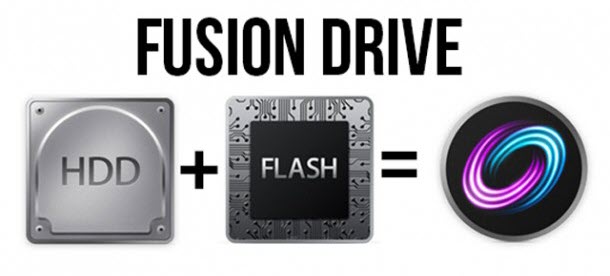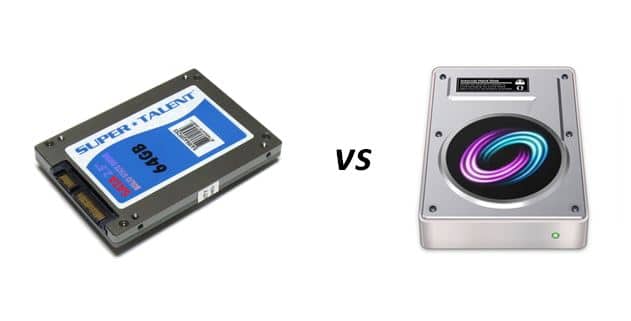The moment I would end up writing the first line of this article, only God would know about the amount of data produced globally within the same time frame. That is where this area of discussion is going to drift towards – Data Storage! The entire world is generating data at a tremendous and exponential rate every single second from our smart gadgets, that’s why it becomes very crucial for us to store and manage this emerging data effectively and precisely.
Today there are plenty of data storage devices present worldwide, but we will be extracting a deeper knowledge on SSD vs Fusion Drive.
Lets first ponder over the individual identities and existence of SSDs and Fusion Drives.
SSD

SSD stands for Solid State Drive or Solid State Disks. It is a commonly used storage device that has taken over the traditional mechanical hard disks, with effective use of flash-based memory in it. It is a nonvolatile storage media. This new generation of storage devices is widely used in computers and laptops and has drastically increased its processing speed.
The reason behind SSDs faster speed is due to its low read-access time and faster throughput. SSD controller is optimized to deliver high read and write performance for either random or sequential data. The storage technology of a computer decides its processing speed that is the reason why some decade back computers ran slow.
It is even known as Flash Disks/ Drives. Unlike HDD it does not have any moving parts to break or spinning up and down, instead works differently by using a simple memory chip called NAND Flash Memory, which has no moving parts and near-instant access times.
In the early time, SSD technology was used occasionally in the military, supercomputers, and aerospace sectors, not widely used in consumer devices until the 1990s, because of its costliness and limited period.
Two key components make up an SSD:
- Flash Controller: Its work is to manage stored data on flash memory and communicates with a computer or electronic device.
- NAND Flash Memory: It saves data as blocks and then depends on the electric circuits to store data. When power is detached from it, a metal-oxide-semiconductor will provide an extra charge to the memory cell, for keeping up the data.
Working of an SSD
An SSD reads and writes the data to a silicon substrate of interconnected flash memory chips. Special care has to be made from the manufacturer’s end while building SSDs. Silicon chips are stacked in a grid to achieve varying densities. It is designed with floating gate transistors to hold the electrical charge and retains stored data even when it is not connected to a power source. Every block of data is accessible at a consistent speed. However, SSDs can only write to empty blocks.
SSDs will use three main types of memory:
- Single-level cells: Holds one-bit data at a time along with the fastest segment.
- Multi-level cells: Holds two-bit of data per cell with slower writing speed.
- Triple-level cells: It can hold three-bits of data in a cell with slower writing speed and less durability.
To attach the SSD to a system, it is needed to connect using a specific interface. Some of the common interfaces are:
- m-SATA III, SATA III, and traditional SSDs
- PCIe and NVMe SSDs: PCI Express is normally used to connect graphics cards, network cards, or other high-performance peripherals. NVMe offers higher input-output per second with lower latency than SATA.
Read Also: Best laptops for trading which come with SSD
Usage of an SSD
SSD comes with vibrant features and in wide range for its use in different sectors. Some of the sectors are to be listed below-
- Education: Today, the world has shifted online, and education is an important part of this changing era is shifting its physical means too. SSDs are a vital part of PCs, laptops, smartphones, and computers. In this manner, it plays an inevitable role in the education sector.
- Business: Companies working with huge amounts of data rely on SSDs for their overall management, maintenance, trading, and marketing.
- Gaming: Boom! The fascinating area of the world, which requires an immense gaming speed along with a lot of storage backup.
- Servers: Enterprise servers need SSDs to get fast reads and writes to serve their clients’ needs properly.
- Mobility: SSDs have low power requirements, thus contributing to better battery life in laptops and tablets also being shock resistant.
Fusion Drive

Fusion Drives is a name given to the devices used in Apple Inc. These are a hybrid hard drive whose inbuild logic is really simple and basic. As the name suggests itself that it is a combination of two fused components together, this is what Apple has used as a simple fundamental to design these fusion drives which is by combining a traditional Hard Disk Drive and a Flash Storage Drive.
The macOS places the more frequently accessed files, including the OS itself, and the frequently used apps on the flash storage part of the drive so that they are quickly obtained, while the less frequently used data is stored on the hard drive. The benefit of this methodology is that one gets the best of both the worlds.
- Faster operational speed by organizing the most regular data on the Flash part of the Fusion Drive
- Ample amount of storage space for keeping all the media files and more backed up frequently.
Now talking about the availability and the pricing of Fusion Drives:
- Availability: It is quite surprising to digest the fact that not every Apple device contains this Fusion Drive in it. On finding it would be known that MacBook, Mac mini, Mac Pro, or iMac Pro is not having fusion drive in it. However, in case of an iMac, chances are it will be either crafted with a Fusion Drive (default) or eventually one needs to add Fusion Drive in future.
- Price: It comes with a variable price depending on the purpose of use starting range from 1245 USD – 2670 USD.
SSD vs Fusion Drive
| Properties | Solid State Disks | Fusion Drive |
| SPEED | Very fast | Comparatively slower |
| STORAGE TECHNOLOGY | Very fast storage | Fast storage |
| RPM | Higher RPM | Lower RPM |
| NOISE CREATION | Creates noisy | Less noisy |
| READ/WRITE OPERATION | Fast | Slow |
| PRICE | Expensive | Cheaper |
| POWER CONSUMPTION | Lower | Higher |
After reading all the above points of differences and utilities, it’s all up to the person, kind of requirement, and the budget that which storage device he/she needs to use.








